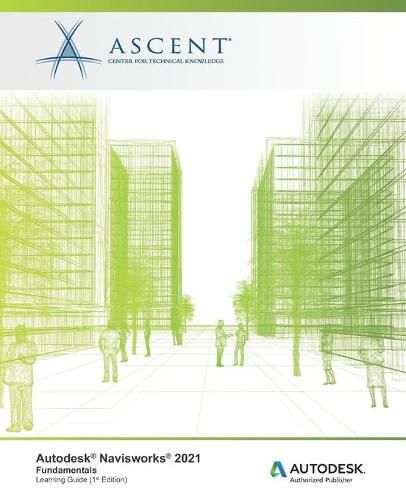Readings Newsletter
Become a Readings Member to make your shopping experience even easier.
Sign in or sign up for free!
You’re not far away from qualifying for FREE standard shipping within Australia
You’ve qualified for FREE standard shipping within Australia
The cart is loading…






The Autodesk® Navisworks® 2021: Fundamentals guide teaches you how to better predict project outcomes, reduce conflicts and changes, and achieve lower project risk using the Autodesk® Navisworks® Manage software in a BIM workflow.
Building Information Modeling (BIM) encompasses the entire building life cycle. BIM includes all phases of the design process, from model creation to construction and ending at operations and maintenance. Using a BIM workflow, you will learn how a design changes throughout the BIM process and how the changes affect the BIM model.
Over the course of this guide, you will learn how to consolidate civil, architectural, structural, and MEP models into one BIM model. Starting with an Autodesk® Civil 3D® drawing file, you will append various Autodesk® Revit® and Autodesk® Inventor® models and check for conflicts. Next, you will use review and markup tools for communicating issues across disciplines. Finally, you will use TimeLiner, Animator, and Clash Detective to simulate construction and find constructibility issues and on-site clashes.
This guide is designed for new and experienced users of the Autodesk Navisworks software in multiple disciplines.
Topics Covered
Understanding the purpose of Building Information Modeling (BIM) and how it is applied in the Autodesk Navisworks software. Consolidate Models Navigating the Autodesk Navisworks workspace and interface. Creating a composite model. Transforming models for proper alignment. Review and Analyze Models Using basic viewing tools. Saving and retrieving views. Sectioning a model. Investigating properties. Searching for items. Hiding and unhiding items. Communication Measuring a model. Adding tags and comments to model components. Marking up and redlining the model. Animate a model. Writing scripts for interacting with the model. Creating photorealistic images. Collaboration Reviewing a model for clashes. Consolidating redlines from other team members. Performing quantification calculations and material takeoffs. Construction Creating a construction timeline. Animating a construction timeline. Prerequisites
Access to the 2021.0 version of the software, to ensure compatibility with this guide. Future software updates that are released by Autodesk may include changes that are not reflected in this guide. The practices and files included with this guide might not be compatible with prior versions (e.g., 2020). The 2021 Civil 3D Object Enabler must be installed on the computer running Navisworks.
A working knowledge of 3D design and task-scheduling software is recommended.
$9.00 standard shipping within Australia
FREE standard shipping within Australia for orders over $100.00
Express & International shipping calculated at checkout
Stock availability can be subject to change without notice. We recommend calling the shop or contacting our online team to check availability of low stock items. Please see our Shopping Online page for more details.
The Autodesk® Navisworks® 2021: Fundamentals guide teaches you how to better predict project outcomes, reduce conflicts and changes, and achieve lower project risk using the Autodesk® Navisworks® Manage software in a BIM workflow.
Building Information Modeling (BIM) encompasses the entire building life cycle. BIM includes all phases of the design process, from model creation to construction and ending at operations and maintenance. Using a BIM workflow, you will learn how a design changes throughout the BIM process and how the changes affect the BIM model.
Over the course of this guide, you will learn how to consolidate civil, architectural, structural, and MEP models into one BIM model. Starting with an Autodesk® Civil 3D® drawing file, you will append various Autodesk® Revit® and Autodesk® Inventor® models and check for conflicts. Next, you will use review and markup tools for communicating issues across disciplines. Finally, you will use TimeLiner, Animator, and Clash Detective to simulate construction and find constructibility issues and on-site clashes.
This guide is designed for new and experienced users of the Autodesk Navisworks software in multiple disciplines.
Topics Covered
Understanding the purpose of Building Information Modeling (BIM) and how it is applied in the Autodesk Navisworks software. Consolidate Models Navigating the Autodesk Navisworks workspace and interface. Creating a composite model. Transforming models for proper alignment. Review and Analyze Models Using basic viewing tools. Saving and retrieving views. Sectioning a model. Investigating properties. Searching for items. Hiding and unhiding items. Communication Measuring a model. Adding tags and comments to model components. Marking up and redlining the model. Animate a model. Writing scripts for interacting with the model. Creating photorealistic images. Collaboration Reviewing a model for clashes. Consolidating redlines from other team members. Performing quantification calculations and material takeoffs. Construction Creating a construction timeline. Animating a construction timeline. Prerequisites
Access to the 2021.0 version of the software, to ensure compatibility with this guide. Future software updates that are released by Autodesk may include changes that are not reflected in this guide. The practices and files included with this guide might not be compatible with prior versions (e.g., 2020). The 2021 Civil 3D Object Enabler must be installed on the computer running Navisworks.
A working knowledge of 3D design and task-scheduling software is recommended.